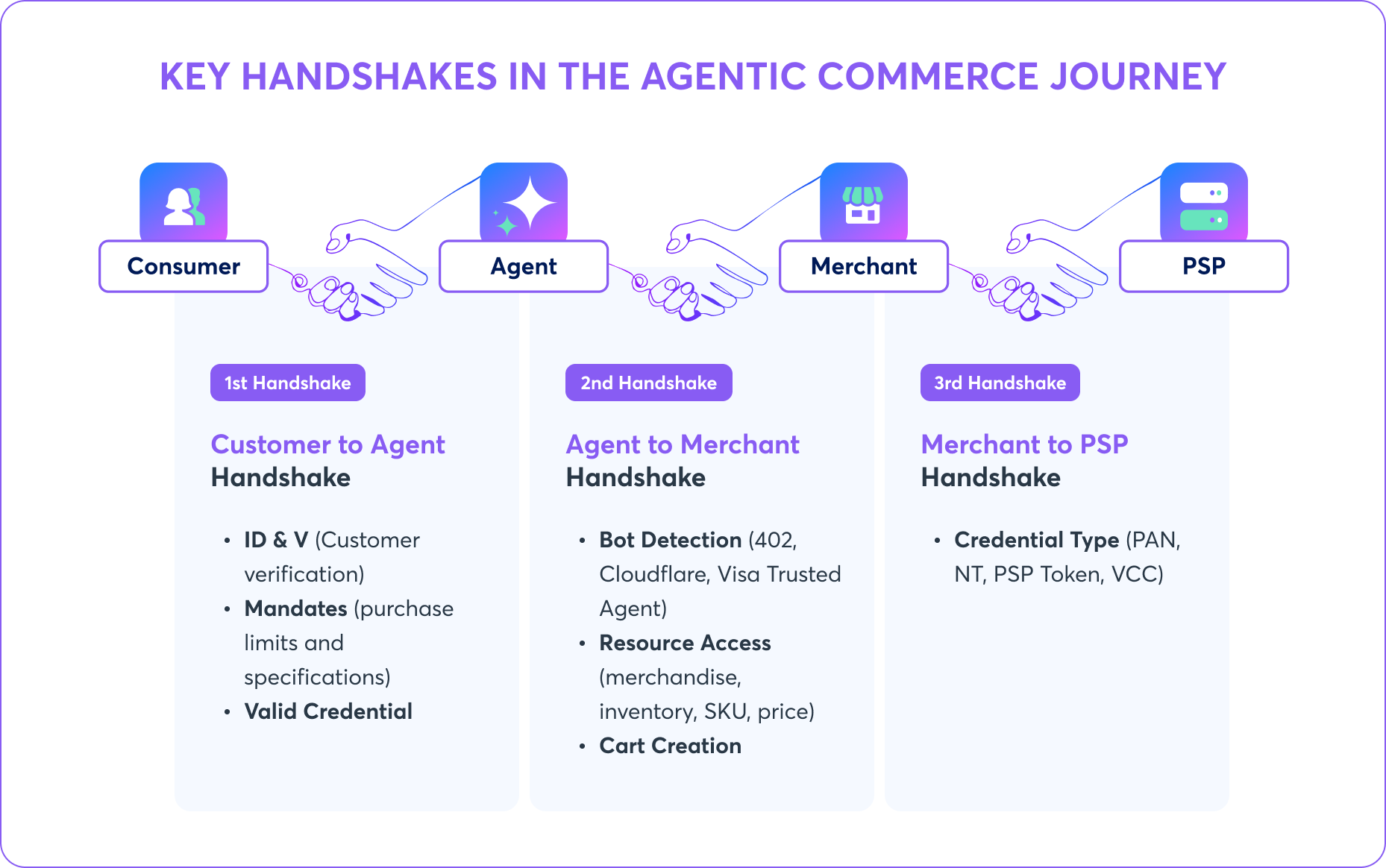Agentic commerce is already reshaping the way consumers shop and engage with brands. One striking data point highlights how quickly this trend is gaining traction: 78% of consumers have used AI for product research and shopping in the past three months.
As commerce becomes increasingly agentic, the shift toward protocol-driven interactions promises speed, privacy, and automation. Yet, somewhere between mandates and protocols, a dangerous gap is forming. Merchants are losing sight of their customer payment data altogether. Our goal is to help merchants prepare for the coming wave of agentic commerce. At VGS, we believe that this is an incredible new channel.

Why This Matters for Merchants
In an agent-driven commerce flow, a substantial amount of information must be transferred securely and in sync across multiple parties for a single transaction to succeed. Yet, despite all this data being gathered, transformed, and exchanged behind the scenes, the merchant or PSP ultimately sees only a small slice of it. Each participant in the chain holds a different view of the transaction, with limited visibility into what the others know.
To understand how these distributed pieces come together to enable a fully agentic purchase experience, it helps to break down the series of “handshakes” that occur between parties throughout the end-to-end flow.

-
Consumer-to-Agent handshake
In the first handshake, the user delegates control to an agent.
In this handshake, a customer passes key pieces of information to an agent, including:
- Identity and verification: This is when an agent verifies that the user is who they say they are. This can happen via 3DS, passkeys, and other methods.
- Mandates: The user sets a mandate. The mandates can be purchase price limits, quantity of items, specific colors, or even airfare times. For example, they can input, 'I want to buy a plane ticket for less than $500 at any airline to New York.'
- Valid credentials: The user will need to have a valid form of payment to make the purchase.
-
Agent-to-Merchant Handshake
The second handshake is when the agent interacts with the merchant.
In this handshake, an agent needs to interact with a merchant in a variety of ways, including:
- Bot detection/Agent Identification: An agent signals they are legitimate and not a bot.
- Accessibility to a merchant's inventory/SKU: The agent must be able to access product names, product descriptions, prices, colors, sizes, availability, etc.
- Cart Creation: The agent needs the ability to create a cart on the merchant's website.
-
Merchant-to-PSP Handshake
Finally, the last handshake is when the merchant connects with its Payment Service Provider (PSP).
In this handshake, a merchant needs to pass one key piece of information to a PSP:
- Payment Credential: The merchants must have a payment credential. This can be a PAN, Network Token, PSP Token, Virtual Card, or any other defined credential. This ensures that the PSP can process the transaction and complete the final step.
The last step in the agentic commerce payment journey is ensuring the merchant receives payment. But not all payment methods are created equal.
Pros
Cons
PAN
- Works with existing infrastructure
- Allows merchant access to payment for recurring billing, COF, fraud, chargebacks, CRM, loyalty
- PSP Agnostic - Route to any PSP
- Merchant must be PCI Compliant
- No Lifecycle Updates
- Must capture CVV
Network Token
- Works with existing infrastructure
- Automatic Card Lifecycle Updates
- Merchant doesn't need to be PCI compliant
- Universal Acceptance:
- PSP Agnostic - Route to any PSP
- Compatibility: Merchant will need to understand/ setup in system if not live already
Virtual Card
- Works with existing infrastructure
- Quick to adopt (good for POC)
- Merchant loses access to payment for recurring billing, COF, fraud, chargebacks, CRM, loyalty
- Expensive
- Single Use
Agentic Token
- Holds many controls to ensure transaction is from a legitimate user for a specified use case
- Emerging Infrastructure - Not live in market; untested
- Requires significant user verification burden
- Single Use
PSP Tokens
- Works if using a single PSP
- Only available on Stripe
Wallets
- Identity layer embedded natively
- Leverages Network Tokens (works with existing infrastructure)
- Merchant needs to enable as payment option
Blockchain
- Tested and works
- Inexpensive rails
- Emerging Infrastructure - Limited adoption
The additional steps in a payment flow (e.g., authorization rates, chargebacks, etc.) continue as a typical transaction flow.
Key Takeaway
In each of these handshakes, data is exchanged between parties to verify that a legitimate, human-initiated transaction is occurring. When a user searches for new furniture on an agent platform, they must trust that the agent will authorize only the transaction they've approved, and merchants need that same assurance. However, as shown in these handshakes, the most valuable data is primarily shared with the agent, while little of it is passed downstream to the merchant or the PSP.
For merchants, this creates a structural infrastructure gap. The systems merchants rely on today, such as fraud engines, loyalty programs, customer profiles, chargeback workflows, personalization engines, and even basic transaction routing, were all built on the assumption that they would have direct access to both user identity and behavioral context. In agentic commerce, that context disappears unless a dedicated layer exists to securely capture and distribute it.
Without an infrastructure partner to reintroduce this data into merchant systems in a standardized, privacy-preserving way, merchants are left unable to make informed decisions, optimize conversions, or maintain meaningful customer relationships in an agent-driven world.
Merchants need a data infrastructure that prioritizes their needs.
VGS is the agentic commerce infrastructure that provides merchants with the data they need.
As agentic commerce continues to evolve, shared data is becoming critical to maintaining trust and efficiency across the ecosystem.
Contact VGS to learn how we can help you.
Contact Us



